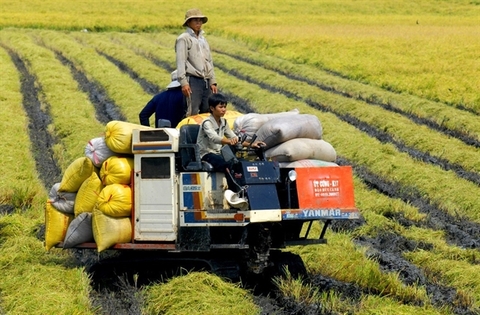 |
After six months of launching, Doveco Gia Lai Vegetable Fruit Processing Centre under Dong Giao Foodstuff Export JSC is operating at peak performance to complete orders from 30 countries around the world, including high demand markets such as Europe, Israel, Japan, and the United States.
Doveco Gia Lai is a modern agricultural processing factory complex with three automated production lines, including concentrated and natural fruit juice production lines, a frozen fruit and vegetable production line, and a canned fruit and vegetable production line with a capacity of 20,000, 22,000, and 10,000 tonnes per year respectively. Currently, these lines are supporting each other in producing and processing a large volume of products with diversified lines such as concentrated passion fruit juice, concentrated pineapple juice, frozen and canned fruits, and lots of other fruits and vegetables.
The Doveco factory is expected to be a centralised commodity production area under large-scale sustainable value chains, applying high technology in an area of 10,000-15,000 hectares in the Central Highlands province of Gia Lai.
With two major material production areas and two processing complexes equipped with modern technologies imported from Sweden, German, Italy, and Japan, Dong Giao is Vietnam’s leading agricultural product processing enterprise, and the pioneer in applying and renewing technologies for agricultural sector.
According to the Ministry of Agriculture and Rural Development (MARD), Dong Giao is among many businesses in Vietnam with high-tech production and processing facilities, contributing to the country’s efforts to digitalise its agricultural sector.
For example, Masan MEATLife is one of the frontrunners in Vietnam regarding comprehensive integration of meat value chain, including animal feed production, high-tech pig farms, and chilled meat using state-of-the-art European technology.
Minister of Agriculture and Rural Development Nguyen Xuan Cuong told VIR about Masan’s impressive work, “In 20 to 30 years, there was no modern meat processing factory in Vietnam, even though the country is famous for its quality of meat. However, within just 11 months, Masan completed a VND1 trillion ($43.47 million) processing complex, producing goods meeting international standards,” said Cuong.
One piece of technology that has helped Masan gain such success is oxy fresh, which helps prevent bacteria and retain the quality of meat.
Another example of a company actively applying technology to agricultural production is Viet Uc Seafood Corporation. As one of the biggest companies in shrimp farming, Viet Uc identifies tech as a key element in modern agricultural production, particularly when the impact of climate change is being increasingly felt in the Mekong Delta, where the company’s farms and factories are based. “Normally, the ideal temperature and salt level for shrimp farming is from 28-32°C and 15-25 grammes per litre, but salinisation has increased the salt rate to above 30g per litre,” said Luong Van Thanh, group general director. “The high temperature can be dangerous for shrimp.”
According to Thanh, to avoid the harmful effects of the environment, his group has used greenhouses surrounding farms along with sedimentation and ultrafiltration ponds, ensuring the cleanliness of the water. The ponds’ beds are also covered with plastic canvas and installed with a complete fan and oxygen system.
“All our farms are equipped with automatic feeding lines. Whenever the shrimp get hungry, censors will catch the signal and automatically start feeding lines,” Thanh said. “Moreover, our bio-handling process helps maintain water temperature and quality. These modern technologies help reduce feed waste and water consumption to the lowest level.”
He added that carefully monitoring every developmental stage of the shrimp helps the group control the farms’ operation and original traceability easily.
“These technologies are transferred to support enterprises and households farming shrimp. We also study solutions to improve the quality of shrimp seedling for shrimp farmers around the country,” Thanh said.
Along with Doveco, Masan, and Viet Uc, many other small- and medium-sized enterprises have been applying technologies in their farms. With vegetable farms covering over 1,000ha in the northern provinces of Ninh Binh and Vinh Phuc, and Hanoi’s Me Linh district, Vietnam Agricultural Products Ltd., Co has also applied modern technology in its farming activities. “Our farms use automated systems for watering and fertilising. Accordingly, the censors will kick off the systems to ensure humidity and nutrition for plants,” Tran Thi Thu Hang, director of the company, told VIR.
According to her, thanks to the system, her farms can save a lot of money this way. “Before, without the technology, we needed dozens of workers, but now, just two or three people are enough. Water and fertiliser expenses have also reduced by half,” Hang said.
Meanwhile, Pham Tien Sinh, director of Hoa Binh Gap Ltd., Co melon-producing company told VIR about how technology has helped his firm. “By using Israeli drip watering system and greenhouse we can create safe products without chemicals while saving a lot of expense. Besides this, with a Japanese technology, we can measure the sweetness and nutritional value of our melons, based on a variety of factors. Thanks to this tech, our product is popular with consumers, and we have plans to export in the near future.”
Stories of companies applying technologies in farming and processing have shown that Vietnam’s agriculture is strongly moving towards digitalisation. Minister Cuong highly spoke of their proactiveness: “It’s clear that businesses are the backbone of the country’s agriculture, and using this technology is an indispensable trend as Vietnam is quickly integrating into the world.” VIR
Phuong Hao

Challenges compel restructuring in agriculture
Trade conflicts, climate change and epidemics may at first glance appear to be a hindrance to Viet Nam’s agricultural sector.

VN farmers turn to high tech agriculture
Underdeveloped northern provinces were embracing high technology to make breakthroughs in farming productivity in hopes of lifting locals – mostly of ethnic minorities – out of poverty.
 Vietnamese agricultural enterprises are promoting the application of high technologies in production and processing to contribute to restructuring the agricultural sector.
Vietnamese agricultural enterprises are promoting the application of high technologies in production and processing to contribute to restructuring the agricultural sector.